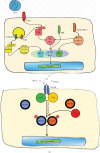Human Type I Interferon Antiviral Effects in Respiratory and Reemerging Viral Infections
- PMID: 32455136
- PMCID: PMC7231083
- DOI: 10.1155/2020/1372494
Human Type I Interferon Antiviral Effects in Respiratory and Reemerging Viral Infections
Abstract
Type I interferons (IFN-I) are a group of related proteins that help regulate the activity of the immune system and play a key role in host defense against viral infections. Upon infection, the IFN-I are rapidly secreted and induce a wide range of effects that not only act upon innate immune cells but also modulate the adaptive immune system. While IFN-I and many IFN stimulated genes are well-known for their protective antiviral role, recent studies have associated them with potential pathogenic functions. In this review, we summarize the current knowledge regarding the complex effects of human IFN-I responses in respiratory as well as reemerging flavivirus infections of public health significance and the molecular mechanisms by which viral proteins antagonize the establishment of an antiviral host defense. Antiviral effects and immune modulation of IFN-stimulated genes is discussed in resisting and controlling pathogens. Understanding the mechanisms of these processes will be crucial in determining how viral replication can be effectively controlled and in developing safe and effective vaccines and novel therapeutic strategies.
Copyright © 2020 Patricio L. Acosta et al.
Conflict of interest statement
The authors declare that there is no conflict of interest regarding the publication of this paper.
Figures






References
Publication types
MeSH terms
Substances
LinkOut - more resources
Full Text Sources
Medical

